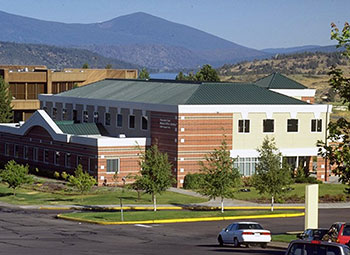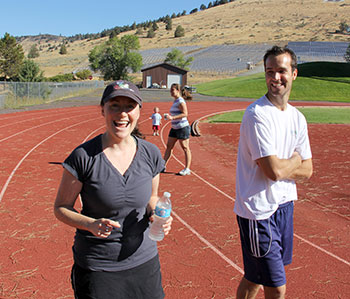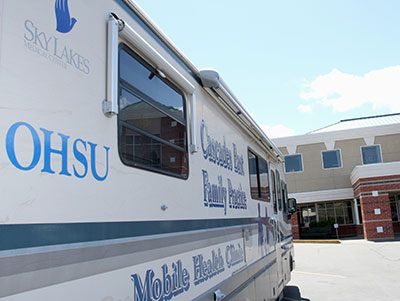By Elizabeth Zach, RCAC Staff Writer
Cascades East Family Medicine Center
Klamath Falls, Oregon

Many doctors have patients they never forget. For Dr. Kent Vincent, it’s a farmer from northeast Oregon. With both arms mangled, then severed by a corn auger, he managed to drive his tractor three miles to a house to get help, and he lived to talk about it.
“I wrote his prosthetic prescriptions for 10 years after that,” says Vincent, an orthopedic surgeon who studied medicine in Iowa.
At the time, Vincent worked at Oregon Health Sciences University in Portland. The farmer was brought there for treatment. Looking back, Vincent says that it wouldn’t have made much difference had a doctor been near the accident, but Vincent’s familiarity with farming and rural living was an asset.
“Having studied medicine in Iowa, I know all about these injuries,” he says. “The really tough stuff was injuries with corn pickers, these really powerful implements that can sever limbs.”
He says that while he enjoyed his time training in rural Iowa, he decided to move to and raise his family in a city to be near better schools. He now practices at a small clinic in Tucson, where he specializes in pediatric orthopedics.
These days, the U.S. faces a shortage of doctors serving rural areas, and specifically physicians committed to working in primary care. The National Organization of State Offices of Rural Health has marked November 20 as National Rural Healthcare Day to highlight rural communities’ unique healthcare needs, including the lack of healthcare providers.
Part of the challenge in addressing the doctor shortage lies with residency funding in rural America, which is far less than urban teaching hospitals receive. This is just one of the reasons why younger doctors are typically less inclined to take jobs in rural America. Another is that specialized medicine is potentially much more lucrative: less than 35 percent of U.S. doctors practice primary and family care. Also, physicians in rural areas can face long hours, are frequently on call, and their spouses may have trouble finding work in isolated regions.
But since 1994, the Cascades East Family Medicine Center in Klamath Falls, Ore., has been bucking this trend. It operates an admirable training program for residents who are intent on practicing medicine in rural areas.

The curriculum, administered by Oregon Health Sciences University, is unique in that it offers residents three years of training in rural medicine; similar programs offer just two. Residents also rotate to more populous areas, such as Portland or Bend, to observe complicated procedures, develop skills, and learn about ailments they wouldn’t ordinarily be exposed to in rural areas. The curriculum also emphasizes maternal-child health and an option for residents to train in obstetrics.
The school receives federal funding, but also benefits from local support from Sky Lakes Medical Center, a 96-bed nonprofit hospital in Klamath Falls.
“Sky Lakes makes a significant investment in our program because it improves the primary care base in the Klamath Basin,” says Cascades East program director, Joyce Hollander-Rodriguez. “The recruitment benefits to communities of having rurally-based residency programs can be large. It is difficult to attract physicians to rural areas and keeping them in a community that they trained in is a benefit to the hospital, medical community and broader population.”
The program has been so successful that it’s turned competitive. Lauded as the best rural medicine training facility in the U.S., this year Cascades East received close to 1,200 applications and, after narrowing the pool to 100 candidates, selected just eight students.
Residencies include stints in so-called “frontier medicine” in very isolated areas with populations of less than 5,000. Residents are required to work in the emergency room, oversee hospital staffing and conduct regular consultations.
“They become the doctor in that kind of setting,” says Brittany Thoma, program manager at Cascades East. “It’s so much hands-on work, and it’s a very popular rotation.” And if they stay on, she adds, “They can become valuable pillars of their communities.”
Sixty percent of Cascades East’s graduates practice in communities with a population of 25,000 or less. Hollander-Rodriguez says, “There’s good evidence to suggest that training in rural areas does affect likelihood of practicing in rural areas.”
She points to a February 2013 study published in the journal Family Medicine, which surveyed the practice characteristics of Cascades East’s residency program graduates, including community size, practice content, procedures and outpatient services.
“It is encouraging,” noted the study authors, “that even 15 years post-residency start-up, many physicians (a majority at 52 percent) are still located in federally defined shortage areas.” Despite the fact that to date there is “virtually no evidence about the most effective way of producing practitioners for rural locations,” according to the report.
And keeping them there presents another hurdle. Researchers studying “social geography” at Dartmouth College found that 55 percent of doctors have well-educated spouses who seek well-paying jobs, and another 10 percent are single. These numbers are increasing, and they represent the people who are least likely to practice medicine in a rural area.
This dilemma has taken center stage in Washington, as two medical schools spar over the best training model for rural care. The University of Washington intends to expand its physician training program in Spokane, which would include broadening its clinical training site network across rural areas of the state. Seven years ago, it established a program that reserves 10 of the student slots per year for students from rural areas of the state.
Meanwhile, Washington State University (WSU) wants to open its own medical school in Spokane, but instead of building a new teaching hospital, it seeks to cooperate with existing hospitals in underserved communities in the state. In addition, WSU would develop training centers around Washington for third- and fourth-year students. The idea, supporters say, would be a boon to nearby small towns, and is a strong strategy for keeping physicians in the small towns where they train, creating in effect a “culture” where they truly want to practice medicine.
But one thing both schools agree on is that more residency programs overall are needed—of the 1,600 positions in Washington, just 100 are in rural eastern Washington.
“More work is definitely needed to address the federal system of funding graduate medical education so that more residency slots exist in primary care,” says Hollander-Rodriguez. “Access to primary care remains a significant issue in rural areas.”
To ease the doctor shortage, some states are considering initiatives that would make it convenient for physicians to obtain licenses in multiple states, all the while keeping standards high. Some requirements bandied about various state legislatures are clean disciplinary records, a specialty certification, passing licensure exams within three attempts and residency completion. Wyoming, for instance, which is one of the largest states in terms of area but has the smallest population, would profit from this sort of license-sharing.

“This is kind of the assurance to legislatures and others that, ‘Hey, this isn’t going to be the lowest way over the fence,’ so to speak,” Kevin Bohnenblust, executive director of the Wyoming Board of Medicine, told Governing magazine this month. “You’re going to be getting good people.”
Another approach is telemedicine, which refers to doctors communicating with patients electronically. It is already a million-dollar business and some analysts predict industry profits to reach $1.8 billion by 2018. The American Telemedicine Association, however, maintains that state and federal laws lag in fully structuring and regulating this fast-growing industry.
“It takes effort to get legislation through the legislatures, particularly those that have very short sessions,” Gary Capistrant, director of public policy for the American Telemedicine Association told Governing. “And if something doesn’t have a lot of support, it just doesn’t make it through the process that fast.”
Meanwhile, Cascades East continues to attract, and graduate, young residents. Dr. Holly Montjoy completed her residency there in June, after leaving behind family in North Carolina three years earlier. For her frontier medicine rotation, she worked at a clinic in John Day, Ore., population 1,744 in the eastern corner of the state. “A beautiful area,” she recalls, where she spent weekends cycling in the nearby Strawberry Mountains.
She is now a member of the Cascades East faculty and she also sees patients.
“It was an adventure to go somewhere new, across the country,” she says. “And I was blown away immediately by the autonomy and the level of care that could be achieved in a rural setting.”
Photos taken by Elizabeth Zach.
